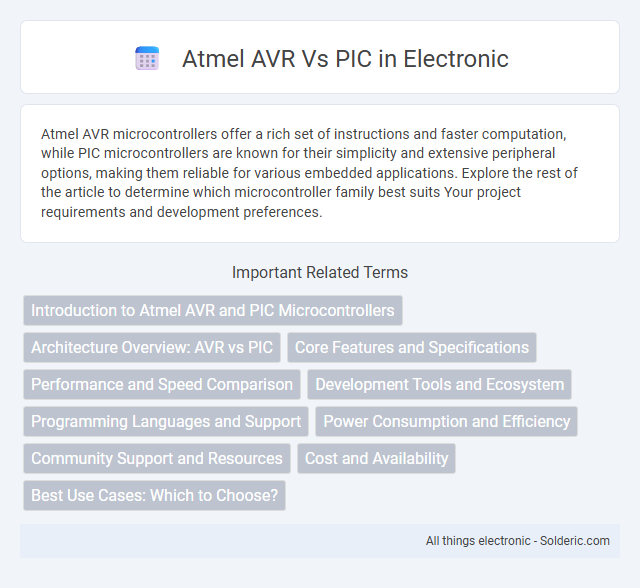Atmel AVR microcontrollers offer a rich set of instructions and faster computation, while PIC microcontrollers are known for their simplicity and extensive peripheral options, making them reliable for various embedded applications. Explore the rest of the article to determine which microcontroller family best suits Your project requirements and development preferences.
Comparison Table
| Feature | Atmel AVR | PIC |
|---|---|---|
| Architecture | Modified Harvard, 8-bit & 32-bit options | Harvard, 8-bit to 16-bit and 32-bit options |
| Instruction Set | RISC, uniform 16-bit instructions | RISC, mixed 8-bit and 16-bit instructions |
| Clock Speed | Up to 20 MHz (8-bit), 48 MHz (32-bit) | Up to 64 MHz |
| Memory | Flash (up to 256KB), SRAM, EEPROM | Flash (up to 128KB+), SRAM, EEPROM |
| Development Tools | Atmel Studio, AVR GCC | MPLAB X IDE, XC Compilers |
| Power Consumption | Low power modes available | Ultra-low power variants available |
| Peripheral Integration | Rich peripherals: ADC, timers, USART, SPI, I2C | Extensive peripherals: ADC, timers, USART, SPI, I2C, CAN |
| Community & Support | Large open-source community | Strong industrial support |
| Typical Applications | Hobbyist & embedded systems | Automotive, industrial, consumer electronics |
Introduction to Atmel AVR and PIC Microcontrollers
Atmel AVR microcontrollers feature 8-bit RISC architecture known for high-speed performance and ease of programming, making them popular in embedded system designs. PIC microcontrollers by Microchip Technology offer a wide range of 8-bit, 16-bit, and 32-bit options with versatile peripherals suited for industrial and consumer applications. Both families provide robust development environments and extensive community support, catering to diverse project requirements and innovation.
Architecture Overview: AVR vs PIC
AVR microcontrollers utilize a modified Harvard architecture with a rich instruction set optimized for single-cycle execution, featuring 32 general-purpose registers directly connected to the arithmetic logic unit (ALU). PIC microcontrollers employ a Harvard architecture as well, but with a more limited instruction set and fewer registers, often requiring multiple cycles per instruction, which can affect processing speed. The AVR's efficient register-to-register operations and shorter instruction execution times generally provide superior performance in embedded applications compared to the PIC's accumulator-based design.
Core Features and Specifications
Atmel AVR microcontrollers feature an 8-bit RISC architecture with a high clock speed of up to 20 MHz, 32 general-purpose registers, and efficient instruction execution that enhances performance for embedded applications. PIC microcontrollers from Microchip offer a diverse range of cores, including 8-bit, 16-bit, and 32-bit variants, with integrated peripherals such as ADCs, UARTs, and timers that support complex control tasks and power-efficient designs. Your choice between AVR and PIC should consider the specific requirements for processing speed, memory size, and peripheral integration to optimize performance and power consumption in your project.
Performance and Speed Comparison
Atmel AVR microcontrollers generally offer higher clock speeds and more efficient instruction execution compared to many PIC variants, resulting in faster performance for time-critical applications. PIC microcontrollers often feature a more extensive range of specialized peripherals, which can enhance processing efficiency in specific tasks despite typically lower clock speeds. Your choice between Atmel AVR and PIC should consider the required operational speed and the nature of the application to optimize overall system performance.
Development Tools and Ecosystem
Atmel AVR microcontrollers benefit from the extensive Atmel Studio IDE, offering integrated debugging, simulation, and a large selection of libraries and example projects tailored for AVR devices. PIC microcontrollers, supported by Microchip's MPLAB X IDE, provide powerful tools such as MPLAB Code Configurator and integrated debugger with wide third-party ecosystem compatibility. Both platforms boast robust ecosystems, but Atmel AVR emphasizes ease of use and community-driven resources, while PIC offers comprehensive professional-grade development with broad hardware support.
Programming Languages and Support
Atmel AVR microcontrollers predominantly utilize C and assembly languages, supported by the widely-used Atmel Studio IDE, which offers comprehensive debugging and simulation tools. PIC microcontrollers are programmed primarily in C and assembly as well, with Microchip MPLAB X IDE providing a robust development environment and extensive third-party toolchain compatibility. Both platforms have strong community support and extensive libraries, but Atmel AVR often benefits from more open-source resources and beginner-friendly tooling.
Power Consumption and Efficiency
Atmel AVR microcontrollers generally exhibit lower power consumption due to their advanced sleep modes and efficient CPU clock management, making them favorable for battery-operated applications. PIC microcontrollers offer a wide range of low-power devices with customizable power-saving features, but their efficiency often depends on specific model configurations and application requirements. Both AVR and PIC families support various power optimization techniques, though AVR's RISC architecture typically leads to higher performance-per-watt ratios in embedded systems.
Community Support and Resources
Atmel AVR microcontrollers benefit from a large, active community with abundant libraries, tutorials, and forums such as AVR Freaks, which facilitate troubleshooting and project development. PIC microcontrollers, supported by Microchip, also have extensive resources including MPLAB X IDE, a rich set of application notes, and a dedicated user base, but AVR's open-source nature often leads to more grassroots contributions. Your choice may depend on whether you prefer AVR's community-driven ecosystem or PIC's corporate-backed support and comprehensive official documentation.
Cost and Availability
Atmel AVR microcontrollers generally offer competitive pricing and widespread availability through numerous global distributors, making them cost-effective for both hobbyists and industrial applications. PIC microcontrollers, produced by Microchip Technology, also maintain a robust supply chain with a broad product range, often priced similarly but occasionally higher for specialized models. Both platforms benefit from extensive distributor networks like Digi-Key and Mouser, ensuring easy procurement and competitive bulk pricing.
Best Use Cases: Which to Choose?
Atmel AVR microcontrollers excel in applications requiring high-speed processing and ease of programming, making them ideal for DIY projects, educational purposes, and rapid prototyping. PIC microcontrollers are preferred in industrial automation and embedded systems due to their robust architecture, extensive peripheral options, and low power consumption. Choosing between Atmel AVR and PIC depends on factors such as processing speed, development ecosystem, power efficiency, and specific project requirements.
Atmel AVR vs PIC Infographic

 solderic.com
solderic.com